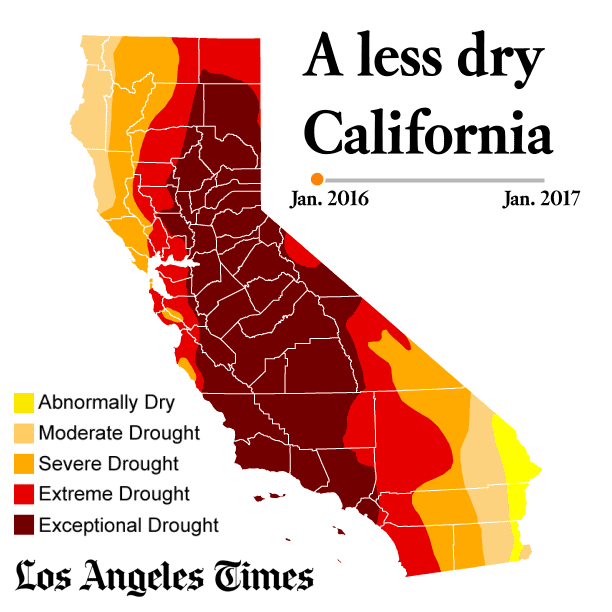Drought conditions across California were steadily improving as we closed out 2016. This past week has further weakened the drought’s stranglehold on the state. A series of severe winter storms continue to saturate the state and, as of this week, more than 40% of the state is now considered by officials to be drought free. The severely drought-stricken areas of Southern California have diminished by 41% and the Sierra snowpack is now at 160% of normal levels.

Drought Snapshot – Source: Los Angeles Times
Storms Fueling Drought Recovery
Since December 1, the storms have brought snow and heavy rainfall to much of the state. Northern California, especially, has seen precipitation levels that rival some of the wettest years on record.
| City | Rainfall (in) Since Dec 1 | Average Annual Rainfall (in) | % of Annual |
| Fresno | 5.14 | 11.5 | 44.70% |
| Monterey | 6.84 | 19.5 | 35.08% |
| Redding | 10.56 | 34.61 | 30.51% |
| Sacramento | 10.82 | 18.51 | 58.45% |
| San Francisco | 7.81 | 23.64 | 33.04% |
| Santa Rosa | 18.29 | 36.28 | 50.41% |
| South Lake Tahoe | 14.88 | 52.45 | 28.37% |
According to UC Davis water expert Jay Lund, “In terms of surface water, most of California is no longer in drought”. Many of the state’s reservoirs are nearing capacity and now at or above historic averages. Lake Shasta, the state’s largest reservoir, has swelled to over 80% capacity and the Bureau of Reclamation opened Shasta Dam for the first time in over 6 years. Managers at many of the state’s other reservoirs are following suit, releasing water in order to make room for future storm and mountain run-off.
Aquifers Have Not Recovered
While the state’s many reservoirs are recovering well, the groundwater aquifers could take decades to recover. Central California’s many farms have relied on groundwater to continue irrigating their farms for much of the five year drought. The result has been a depleting water table, up to fifty feet below historic levels in some areas. For many farmers, this caused a financial burden of digging a deeper well, or many risked the well drying up entirely.
Groundwater depletion has been an ongoing problem in California’s Central Valley, even in years of normal rainfall. The extended drought has exacerbated the problem, and while these recent winter storms will help to replenish some of the groundwater resources, the water table will likely never return to historic levels.
Sources
http://www.latimes.com/local/lanow/la-me-drought-monitor-20170112-story.html
https://weather.com/news/weather/news/atmospheric-river-california-impacts
http://www.latimes.com/local/california/la-me-storms-drought-20170111-story.html




3 Comments